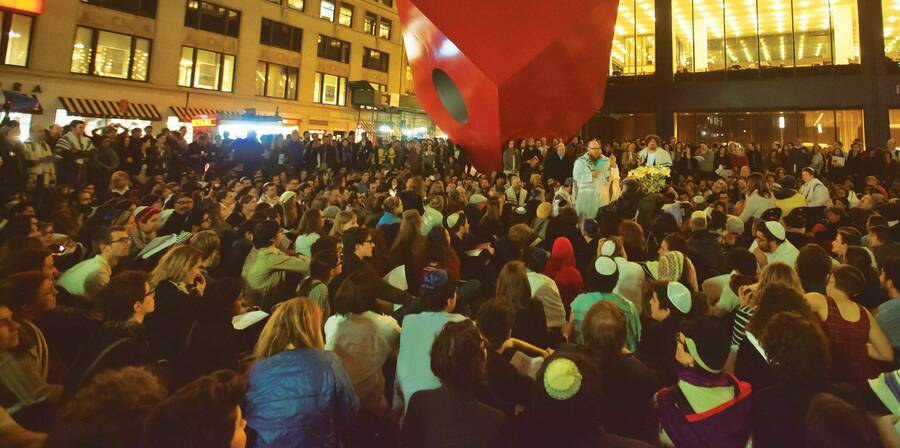
What the Jewish Left Learned From Occupy
An oral history
ON SEPTEMBER 17th, 2011, protesters converged in lower Manhattan’s Zuccotti Park in response to a call to “occupy Wall Street.” Over the next two months, what began as an encampment of several hundred demonstrators grew into a makeshift city—with a field hospital, childcare center, and people’s library—and inspired anti-capitalist actions in more than 900 locations around the world. When police evicted the occupiers that November, organizers cautioned the press, and each other, not to conclude prematurely that the movement had failed. A decade later, lessons from Occupy continue to inform struggles from Black Lives Matter to the fight for universal health care.
Kol Nidre, the evening service that marks the beginning of Yom Kippur, fell on October 7th in 2011, a few weeks into Occupy Wall Street’s short history. As the holiday approached, a group of Jewish participants in the nascent movement, led by organizer Daniel Sieradski, began planning a service to be held in a plaza across the street from Zuccotti Park. The event that came to be known as Occupy Yom Kippur drew hundreds of people and attracted considerable press attention, registering a new current in American Jewish life. Like the Freedom Seder—an interfaith, multiracial Passover meal held in Washington, DC, in 1969 on the first anniversary of Martin Luther King’s assassination, which served as an inspiration for Sieradski—Occupy Yom Kippur repurposed Jewish ritual for public, explicitly political ends. In his sermon, Rabbi Getzel Davis used the image of the Golden Calf to reject “the fallacy that gold is God.” Many participants look back on the service as a pivotal moment in their political education. “That Kol Nidre changed the course of my life,” said attendee Hannah King, who was 18 in 2011. It was “the first time I saw the possibility of being culturally and religiously engaged with politics.”
Occupy Yom Kippur was the most visible of a loose series of ritual protests that came together under the name “Occupy Judaism,” and which turned out to presage a much larger wave of left Jewish movement-building. Though most Jewish organizers at Occupy were not involved in Occupy Judaism, or in Jewish organizing more generally, many of the founders of organizations like IfNotNow first came together in Zuccotti Park; the movement’s energy also revitalized already-existing groups like Jews for Racial and Economic Justice (JFREJ). This outcome would have been hard to predict at the time, since the movement advanced the notion of a unified 99% that elided race, nationality, and colonial legacies. If Jewish organizing occurred only on Occupy’s fringes, opposition to Israel’s occupation of Palestine was pushed outside the movement’s frame altogether. But Occupy’s limitations also impelled a generation of organizers to try to rectify its omissions, galvanizing anti-racist organizing in the US and a new wave of Palestine solidarity activism.
Through interviews with more than 30 people who spent time in the encampment or attended the Kol Nidre service, Jewish Currents staff compiled an oral history of Jewish organizing at Occupy—both in the context of Occupy Judaism, and in the broader movement, where Jewish organizers played a key role. We also spoke with people who engaged in faith-based activism in Zuccotti Park, who sought to introduce anti-imperialist or decolonial thinking into the movement, or who were centrally involved in broader strategic debates. Many interviewees drew connections between their experiences ten years ago and their current work as organizers, illuminating the ways that today’s social movements bear the lasting imprint of Occupy.
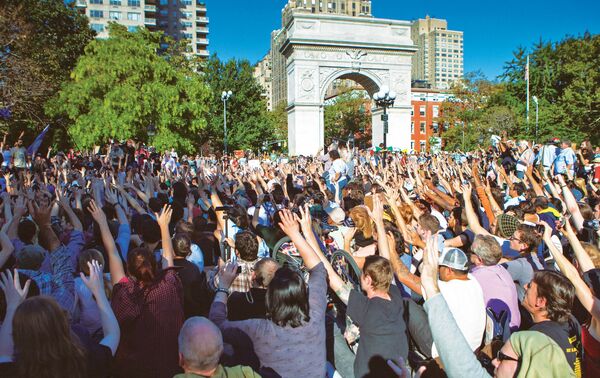
Early Days
Daniel Sieradski (founder, Occupy Judaism): I got involved in Occupy because in 2008 my parents went bankrupt and lost their house and had to move to the middle of the fucking woods. I was furious, because none of the people who were responsible had been held accountable. I was living in New York and working at Repair the World, a Jewish nonprofit. I’ve kind of always been who I am: a progressive Jewish activist who has grave concerns about capitalism. When I saw the call for Occupy, I jumped on board.
Amin Husain (organizer, Decolonize this Place; founding member, Direct Action Front for Palestine): I was in Palestine when the revolution in Tunisia began. We had a feeling that this thing would ricochet. When we came back to Brooklyn, we had comrades from Greece, we had comrades from Egypt[1], and people were sharing information and knowledge. I was there with David Graeber[2] for the first assembly. It wasn’t yet called Occupy Wall Street.
Liza Behrendt (member, Jewish Voice for Peace): The first day, I felt a little unimpressed. Me and my friend were like, “Well, we tried that.” Then the day after the pepper spraying of a few young white women[3] went viral, I went back to an action, and the energy was totally transformed.
Shellyne Rodriguez (organizer, Take Back the Bronx and Decolonize this Place): My first time at Occupy, I get to the park, I see all the signs, and I get scooped into a march through the Stock Exchange area. First time I saw a General Assembly [GA][4] and all the fingers[5]. First time I experienced the people’s mic[6], which we still use.
Liza Behrendt: There was a lot of confusion, but that just drew me in more rather than pushing me away.
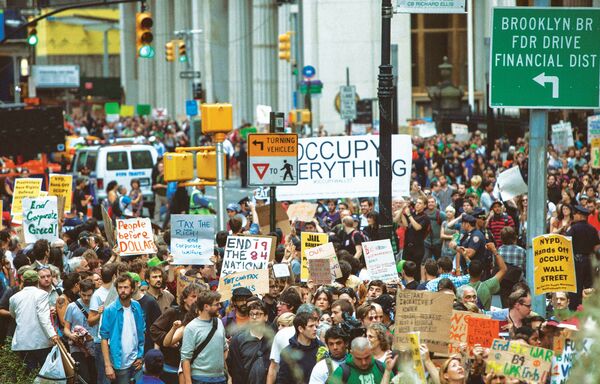
Carinne Luck (co-founder and board member, IfNotNow; founding staffer, J Street): There was a lot of pooh-poohing of [Occupy] by the professional progressive groups. And right from the beginning I thought, “This is interesting. We need something more than what we have right now in the progressive world, and the professional world isn’t cutting it.”
Yotam Marom (co-founder, IfNotNow; founder, The Wildfire Project): One of the major turning points was when Troy Davis was executed by the state of Georgia[7]. I’m pretty sure that was the first mass march that tore through the streets, and the first mass arrest. After that, it was clearly a thing that was picking up steam. More people were coming every day to Zuccotti Park, and it became like a little city.
Carolyn Klaasen (member, Jewish Voice for Peace; PhD student, Union Theological Seminary): I very rarely went with a plan. I would go down there, and then I would realize 48 hours later that I had gotten swept up in things and hadn’t gone back home.
Audrey Sasson (executive director, Jews for Racial and Economic Justice): I was there every day, and when I wasn’t there, I was thinking about it. I was dreaming about it. I talk about it in my journal as having fallen in love.
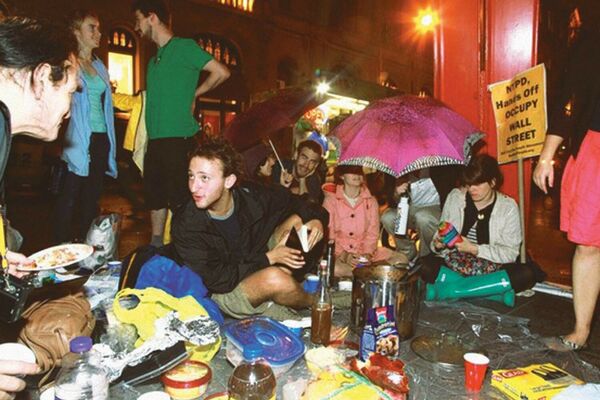
Shellyne Rodriguez: Having experienced multiple movements come and go, what I can say is that there’s a small window in the beginning, a very small window, where that energy is there, where it doesn’t matter who’s around you, everybody’s working together. Before the ego comes out. I feel like Occupy was the first time I saw that happen at that scale. I was like, “Oh, we could really do shit.”
Max Berger (co-founder, IfNotNow; co-founder, Momentum): It was very much a “days were weeks and weeks were months and months were years” kind of time. I was basically organizing there full-time. There was a kind of “managerial class” of Occupy, of people who had some form of organizing experience. Even within that crew, I was part of a group of people who were trying to relate the movement to what was happening politically: to talk about the election, the austerity, the way that the bankers who crashed the economy were still being given preferential treatment. To make it about the housing crisis, and not just about student debt, or whatever set of issues was understood by the press to be animating the movement.
Amin Husain: We fought over the name Occupy Wall Street, because why would you call something “Occupy” when you’re already on occupied land? It’s limiting the potentiality of the formation and the coalition you can create. But people were too stuck. So we conceded the name: Okay, the thing already started, Occupy Wall Street is a hashtag, fine. Now, how do you give this movement an anti-imperial analysis?
Yotam Marom: I didn’t understand the idea of having no demands[8]. I didn’t think that made sense. I tried to move demands through a few different groupings [at Occupy] and made some headway and then it didn’t take. But I recognize that that vagueness was part of what made people feel like it was theirs.
Shellyne Rodriguez: I didn’t think we should be engaging in a conversation about demands. To let demands be the focal point of the conversation is to let our opponents dictate the terms. I didn’t have the language back then to understand that to engage in demands is to engage in reformism.
Daniel Sieradski: At that time I was super involved with the indie minyan scene[9]. Whatever I was going to do at Occupy was going to happen through a Jewish lens. I think it was in the first week that I was like, “Hey, does anybody want to have a Shabbat potluck at Occupy?” I had a decent Twitter following, mostly other Jewish progressives in the New York City area. About a half-dozen or a dozen people came to the first Shabbat potluck. My mom came, she made a pot of cholent[10]. David Peel[11] came down and started singing z’miros[12] with us.
Yotam Marom: I wasn’t thinking about being a Jewish person at Occupy. When I saw Dan and other people doing their thing, it felt to me like another one of the little tribes at Occupy that I appreciated and didn’t want to be a part of. Like, “Yeah, cool, I’m glad there’s a library, but I don’t want to run the library.”
“I wasn’t thinking about being a Jewish person at Occupy. When I saw Dan and other people doing their thing, it felt to me like another one of the little tribes at Occupy that I appreciated and didn’t want to be a part of. Like, ‘Yeah, cool, I’m glad there’s a library, but I don’t want to run the library.’ ”
Liza Behrendt: I looked at [Jewish events at Occupy] as another opportunity to build Occupy, rather than feeling a deep sense of Jewish identity in those spaces. The framing of the movement really flattened and erased identity; I was not particularly aware of any of my identities in the space, as a white person, or a Jewish person, or a queer person. There was a sense that we were all just going with the flow together, which I think did not feel affirming to a lot of people, and probably meant that the movement was less principled and less radical.
Yotam Marom: I definitely noticed that a lot of us in leadership were Jews, disproportionately. It became something I went on to write and talk about: What the fuck is it that all these Jews are on the left and just don’t talk about being Jews?
Menachem Cohen (organizer, Occupy Judaism Chicago; rabbi): [In Chicago,] we made an interfaith group, which I think we called the “spiritual care committee.” We were there to let people know that if they wanted someone to talk to, or some spiritual recharge, we were available. It wasn’t, “Let’s organize as Jews.” It was like, “It’s exciting that we’re a bunch of Jews here.” We took some energy and maybe some pride from it, but we didn’t have a bloc.
Juan Carlos Ruiz (pastor, Church of the Good Shepherd; co-founder, New Sanctuary Coalition; organizer, Occupy Sandy): There was a mixed response to us [as religious figures] at Occupy. Because the Bible, the Quran, has always been in the hand of the conqueror, while the other hand has the sword, or the pistol. Some of us began trying to give a sense of historical memory, because the youth, in their fervor of organizing Occupy, did not have it. There is this whole historical memory that is subversive, these traditions that take on that prophetic voice of the marginalized, of the impoverished. So I began to tap into that and say, “You guys are a link in this chain of solidarity.”
Arthur Waskow (organizer, 1969 Freedom Seder; founder, Shalom Center; rabbi): I went to New York as part of the National Council of Elders, which is made up of veterans of the [social] movements of the 20th century. We got the leaders of Occupy to agree that we would lead a prayer service. Most of those people were totally uninterested in prayer, synagogues, churches. But we created a service that was of its time. There might have been a couple of pages of notes, but certainly there was no printed prayer book. And people loved it. We were astonished.
Daniel Sieradski: I remember there was one communist secularist who was like, “Religion has no place in this movement, it’s a secular movement, you shouldn’t be doing this.” And I remember a couple of antisemites just straight out being like, “Fuck you, get the fuck out of here.” They got shouted down and chased out of the park. But apart from that nobody was ever anti what we were doing. It was always, “Thank you so much for being here.”
Liza Behrendt: I wasn’t quite defining myself or my work as anti-Zionist or in solidarity with Palestine at the time, it was much more anti-[Israeli-]occupation. We were on the edge of grasping a critique of colonialism, but I know I wasn’t there yet.
I never tried to bring Palestine up in a General Assembly. I don’t remember trying to infuse it into any larger strategy in Zuccotti Park, partly because I felt like I didn’t have the stamina to try to impact the larger strategy. But me and Carolyn [Klaasen] and others in the JVP chapter saw Occupy as an opportunity to help bring Palestine into the conversation.
“I wasn’t quite defining myself or my work as anti-Zionist or in solidarity with Palestine at the time, it was much more anti-occupation. We were on the edge of grasping a critique of colonialism, but I know I wasn’t there yet.”
Max Berger: I don’t remember Israel/Palestine being part of the conversation [at Occupy]. I literally can’t remember a single time it came up.
Amin Husain: There was an active resistance to including Palestine. It was presented as a question of strategy, that bringing in “divisive” issues weakens the reach and potential of our movement. I personally never thought that was the case. I thought that you have to do the opposite. Palestine is a litmus test. Palestine is a compass. The thing about Palestine from a perspective of anti-colonial struggle is that when you say “Free Palestine,” you’re saying everything’s on the table.
Daniel Sieradski: At the time I thought, it’s just supposed to be a mass movement for economic justice, not an every-single-issue-under-the-sun movement. And if we start doing things like this, we’re going to alienate a very sizable population of New York City.
Carolyn Klaasen: We finally felt like we found our hook because Birthright NEXT[13] was hosting this speaker—a Wall Street guy who wasn’t Jewish who’d written a book about how great Jews were[14]. I think it was even part of something they were calling a “Wall Street series.”
Liza Behrendt: [The Birthright NEXT action] felt like a chance to speak out against Birthright for their support of the occupation, and to speak out against the erasure of working-class Jews in favor of the wealthiest members of our community. We had a group of 20 or 30 of us, and maybe ten of us went inside. Once the speaker got up, we came to the front one at a time and used the people’s mic to recite a statement. Outside, I believe there were a couple of Palestinian protesters who spoke. But in retrospect, I don’t know if organizing against Birthright in that way was actually building Palestinian-led movements. It lacked a focus on the people most impacted.
Amin Husain: Taking people on the Brooklyn Bridge[15] was a double-edged sword. On the one hand, it broke the media blackout and made the movement global. But its downside was it told people in New York City that these protests are potentially dangerous, that if you get involved in Occupy you may get arrested, you may get maced, you may get beaten. That hurt us. That meant that Palestinians, for example, wouldn’t come. Not just because of the violence. But because [people thought], “Clearly this is a white space, and white people are not going to look out for us.” Who self-selected to show up to the park, and who self-selected not to, made it hard for anti-imperialism to take off.
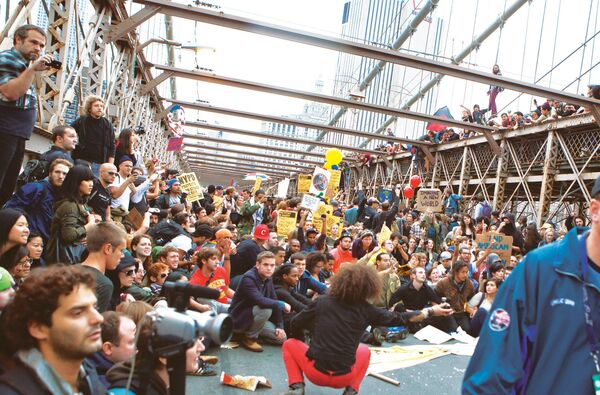
Alana Suskin (organizer, Occupy Judaism DC; rabbi): There was pushback from the right to see Occupy as antisemitic[16], and Occupy Judaism was like, “No, it’s really not.” [In DC,] there was an Occupy Shabbat movement, where people said, “Let’s do Shabbat in our encampments. Let’s be there and be public.” It was a way to claim Judaism as having something to say about this revolutionary change.
Daniel Sieradski: If you talk about the Jewish ethics that inform how one should conduct business, that’s halacha[17]. Sifra ha-Chinuch[18] says one penny in your fortune that is taken from the exploitation of another ruins your entire fortune, and any money taken from that and given to tzedakah makes you doubly a sinner for giving stolen money to a charity. But if you say it in front of goyim, it’s antisemitism. Conservatives took advantage of that.
Carinne Luck: Once accusations of antisemitism started cropping up, I worked with some comms folks from the outside to do a letter. [J Street president] Jeremy Ben-Ami was actually really supportive and signed on saying that Occupy Wall Street was not antisemitic. We pushed that out from Jewish leadership, because of course that became a talking point, as it always does.
Max Berger: When you let in lots of segments of society that don’t typically get to express themselves politically, some of them are going to have antisemitic ideas about where the vast injustices in our society come from. There’s also a segment of Occupy folks who have gone on to become Trump [supporters] or fascist-adjacent. I said at the time that like a quarter of the people there were anarchist libertarians, or just anti-establishment in this way that didn’t have an ideological valence attached to it.
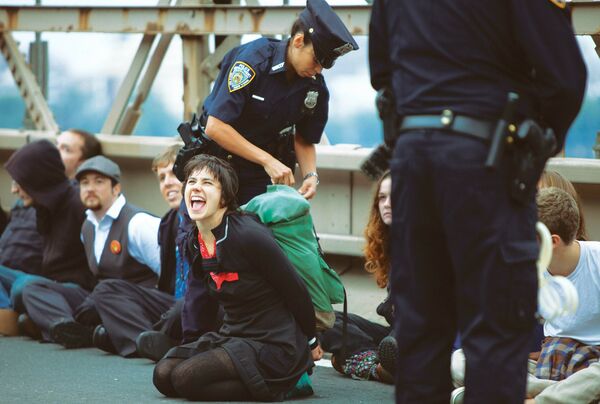
Liza Behrendt: I never encountered antisemitism. I heard stories about weird conspiracy theorists showing up and giving people bad vibes, but I never experienced that.
Daniel Sieradski: I did an interview with Religion Dispatches about how [Jewish] organizations were taking money from hedge funders like Michael Steinhardt[19], all these assholes, and it came back to bite me. My bosses at Repair the World were basically like, “You need to choose now between your activism and your job, because we can’t have you out there insulting our funders and potential funders for their capitalism.” So I quit.
Occupy Yom Kippur and Occupy Sukkot
Dan Sieradski: The original call that I put out on Twitter was: “If I could get Arthur Waskow to come and lead Yom Kippur services at Occupy, would you show up?” And everybody was like, “Hell yeah!” I wanted Arthur to lead because he was tapping into [Rabbi Abraham Joshua] Heschel’s idea that you could “pray with your legs.” But he was very ill. So an hour later, I was like, “What if Arthur couldn’t come?” And they were still like, “Hell yeah!”
In my call on social media I added a link to a PiratePad, which is a collaborative document writing tool, and just put a list of the things we needed: “We need a cantor for this part and a cantor for that part, and we need a Torah scroll, and we need machzors[20], and we need a table, and we need tallit.” Everybody signed up and put what they were gonna bring. It was this completely spontaneous, collaborative, anarchistic, potluck-style indie minyan in the street. It was the same shit I was doing with my friends in our apartments every week, but we did it in front of the Brown Brothers Harriman building, across the street from Zuccotti.
Russ Agdern (co-organizer, Occupy Yom Kippur service): It just snowballed. I had 100 or so yarmulkes left over from my wedding that had been sitting in our apartment. But suddenly 100 was not going to be enough. I reached out to other folks to find stuff. There was a stone soup aspect to it.
Zachary Teutsch (co-organizer, Occupy Yom Kippur DC): A man in his early 20s walked up as we were getting set up. He unzipped his backpack and produced a stack of leather kippot. “I’ve had these since my bar mitzvah,” he said. “But I never knew what they were for. Today, I know.”
Sarah Wolf (co-leader, Occupy Yom Kippur service; Talmudic scholar): [In New York,] we realized that it would be helpful to have a prayer book for people. So I went to the Rabbinical Assembly [RA], which is the religious body of the Conservative movement. It was my first semester at Jewish Theological Seminary[21] and I had this idea of, “This is a countercultural thing I’m doing and maybe people will be weirded out by it.” But the folks at the RA were like, “That’s so awesome that you’re doing that. We got this delivery of 100 sample Ma’ariv[22] pamphlets of the new Lev Shalem machzor[23], and we have nothing to do with them, so just take them.” No hesitation.
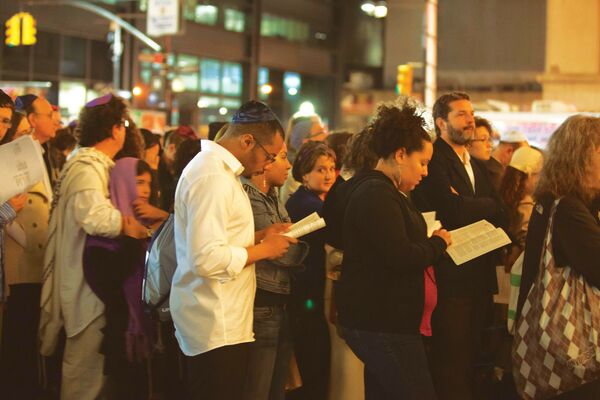
Getzel Davis (co-leader, Occupy Yom Kippur service; rabbi): I think it might have been my suggestion to wear those white kittels[24], to take authority and own the fact that this was a legitimate expression of Yom Kippur.
Ben Murane (former editor-in-chief, Jewschool.com): At first, we had barely a minyan[25], and it occurred to us that the Facebook invite hadn’t made clear where precisely in the park we would hold our service. I remember the surreal experience of wearing my tallis and white kippah while walking through the trees and tent encampment of Zuccotti Park, yelling that our Yom Kippur service would start soon. Most people ignored me. But I recall one young man, laying down in a tent, stood up and asked if he’d heard me correctly. And then he left his tent to follow me out to where our circle of worshippers was growing. A few dozen people who were already part of the encampment joined us that night.
Samuel Stein (attendee, Occupy Yom Kippur; author, Capital City: Gentrification and the Real Estate State): We were surrounded by police and food carts, probably in the worst possible place for them to do business that night. Two rabbis and a cantor stood in the center of the plaza and got everyone’s attention with a mic check. They asked everyone to form concentric circles around them, with taller people in the back. They distributed some machzors and kippot, and created aisles through the crowd. Some people brought folding chairs, but most of us stood and sat on the concrete. All instructions were given in call-and-response so that everyone could hear.
“It was this completely spontaneous, collaborative, anarchistic, potluck-style indie minyan in the street. It was the same shit I was doing with my friends in our apartments every week, but we did it in front of the Brown Brothers Harriman building, across the street from Zuccotti.”
Hannah King (attendee, Occupy Yom Kippur): I was a college sophomore who had been watching Occupy with admiration from Philly, and had been shipped up to Crown Heights for the chagim[26]. In a moment of 18-year-old bravery, I announced that I was “davening elsewhere” for Kol Nidre. I took the train into Manhattan by myself.
That Kol Nidre changed my life, and I remember nearly every moment of it. It was the first time I had ever seen queer frum[27] people, it was the first time I had davened in public. I met many people that night who fully changed the trajectory of my life. I had spent many years in lefty spaces, neglecting to mention my Judaism, feeling that it wasn’t relevant, feeling ashamed about Palestine. This was the first time I saw the possibility of being culturally and religiously engaged with politics.
Daniel Sieradski: What I remember most was the mic checking. Having people say your sermon back to you as loudly as they can so everyone around you can hear is incredibly powerful. I remember the moments of silence when you had a thousand people sitting in a circle, and everybody was hushed and listening intently. In the middle of New York City, with the taxis rushing by and the cops against the wall. It was just something else.
Russ Agdern: Somebody had emailed a bunch of strong-voiced musical folks, and was like, “Hey, can you guys sit close to the middle and help us get the sound out so people can follow the service?” So somebody would say something, then a bunch of people would echo it, and then sometimes, a second bunch of people would echo that. It was such a large group of people that sometimes there were three echoes.
Glenda McKinney (attendee, Occupy Yom Kippur): I was a recent widow, and my son had invited me to come to New York for Yom Kippur, because my late husband had always chanted the haftarah for Yom Kippur for our small congregation in Austin. I was afraid that hearing someone else chant the familiar passage would be devastating, so he wanted to get me into a different environment that wouldn’t be so memory-laden.
I remember being astonished by the number of people who showed up. But the crowd became a congregation and had none of the unruliness I expect at political rallies or music festivals. It was a holy day. Experiencing the people’s mic for the first time in such a singular state of grieving allowed me to transcendentally connect through time to Jews at that point in our annual cycle—and to all crowds gathering as congregations at times of hope and despair.
“The crowd became a congregation.”
Irene Lehrer Sandalow (attendee, Occupy Yom Kippur): I remember how close we all sat next to each other. While I usually attend Orthodox services, going to shul [during that time] would have felt like giving korbanot[28] while leaving the poor to die. I didn’t feel like the service was watered down or kumbaya-y. It had a strong sense of urgency.
Getzel Davis: It was a very particular process for me to write the sermon knowing everyone was going to have to repeat it. It felt like I really had to be clear about every word that I used, trying to say things that I could imagine everyone else saying. I joked that no one could fall asleep in a service with a people’s mic. I actually found that it was deeply moving to speak and hear my words like that. It felt like the words were not just mine. It almost felt like the focus of God’s attention was right in that place at that moment.
Samuel Stein: [At the end of his sermon,] the rabbi talked about oaths—how in Judaism, the oaths we take are less about what we say and more about what we do. He used that to talk about how difficult it is to change our everyday practice, but how important it is, given the inequities that we live with. That led him into an unconventional Aleinu[29]. Aleinu, he said, is our commitment to serve, and do better in the future. So he had people shout out things they could commit to doing in the next year, and if anyone wanted to take on that commitment too, they could shout “aleinu” afterward. They ranged from “I will call my mother more often” and “I will question my own assumptions” to “I will work to end capitalism” and “I will fight for a living wage for all workers.” People were shy at first, but after a few there were too many hands up to call on. After about 20 oaths, the rabbi had everyone yell out their own oath at the same time, and we all did, and laughed, and then sang the end of Aleinu together.
Avi Fox-Rosen: It was an open call: “What are you taking upon yourself?” Basically, “aleinu” means, “This is our responsibility.”
The language I was raised with was very much about personal accounting. Whether or not that’s true to the history of these rituals, in America, if you’re a liberal Jew, you think [on Yom Kippur], “What have I done wrong?” And Occupy presented an opportunity to think about what systems we commit to without our consent that are wrong.
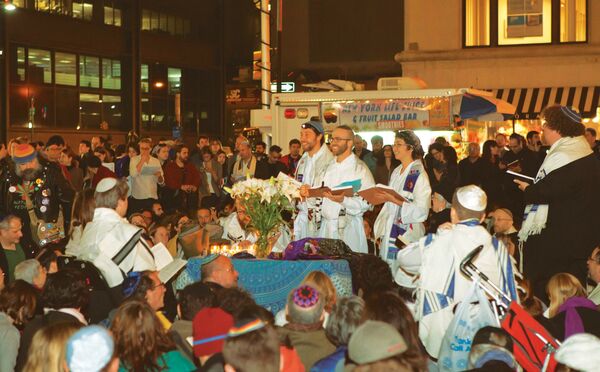
Sarah Wolf: Planning the service had involved making this shift from thinking about Yom Kippur as something that was more personal to thinking about it as something more communal. I think that is honestly what it’s about. Its liturgy is all written in the first-person plural. It’s all collective prayers for the community. But I had never experienced it in quite that way before.
Max Socol (organizer, Bend the Arc; organizer, Occupy Yom Kippur DC): [In DC,] we chanted the Torah and haftarah portions in Hebrew and then in English, and I vividly remember that I had never read the words of Isaiah in English[30] and—even as a Jewish educator with all the proper credentials—had no idea that they were a call to spiritual rebellion beyond the fast.
Yotam Marom: Every year I would go with my family to a synagogue close to where I live in Jersey. We went there begrudgingly, and hating it was part of the ritual. Then we would go eat dinner right after. That was the one day we went to temple every year.
On Yom Kippur, I was planning to go, but somehow I convinced my parents to come to the occupation instead. They had been there before—I had been arrested four or five times already and they had come to check on me. So we did it together there and it was beautiful. It was the first Yom Kippur where I felt genuinely connected to the thing.
Yonah Lieberman (co-founder, IfNotNow): I was in Michigan, sitting in my college house hundreds of miles from New York, glued to the livestream of the service. The images of Jewish protesters, some wearing tallitot, praying in the midst of that movement, will always stick with me. It was the first time I had ever seen Jewish ritual merged with political protest, and it had a huge impact on me and my organizing journey over the last decade.
Sarah Wolf: I remember looking out over the crowd and seeing my then-boyfriend’s secular friends from high school. I was starting rabbinical school, and had become more religiously observant over the last couple years, and felt this sense of, “Is this disconnecting me from my non-Jewish friends, or my more secular Jewish friends?” So to have this experience with people very different from me, expressing shared values through this religious ritual, was very powerful.
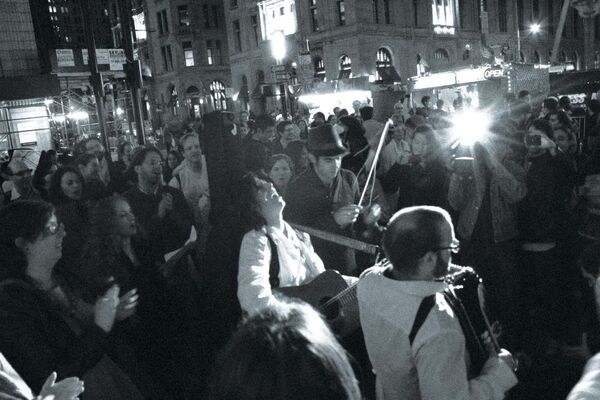
Daniel Sieradski: There was a dance party afterwards, a klezmer dance party. Who ever celebrated on Yom Kippur? But it erupted into this ecstatic song and dance. It’s a day of solemn mourning, but we were so excited because the Jewish community had finally gotten it right. We were like, “Holy shit! This finally makes sense! We’re doing it in the world and not just from a book in a shul where it’s all disconnected and abstracted.” I think that was just intoxicating for people.
Tamara Shapiro (co-founder, IfNotNow and Movement Netlab; coordinator, Occupy Sandy): I was, at that time, really deep in trying to fight Jewish institutions over what we can and can’t say, how we can and can’t run things—and then here was this service where we could say whatever we wanted. Something clicked for me that night about the power of what we [at Occupy] were calling horizontalism[31]. So—even though Jewish organizing was by no means the way that I was deeply involved at Occupy—that event itself really was transformational for me in understanding what the power of decentralizing was all about.
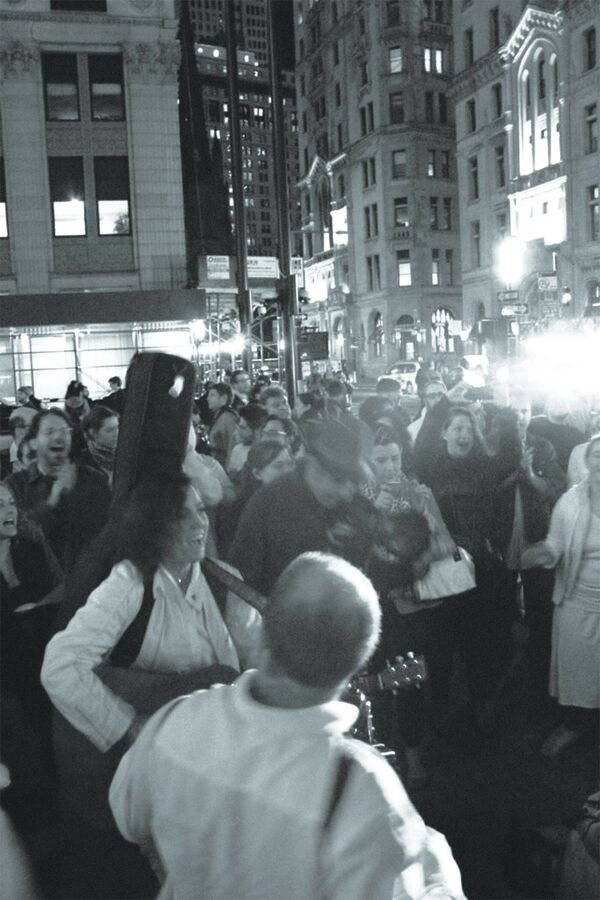
Joel Feingold (co-founder, Crown Heights Tenant Union): I remember being sort of annoyed at Occupy Yom Kippur conceptually. It felt like what IfNotNow would become later: a pivot away from Jews as fellow workers in the 99%, toward a more identitarian and specifically religious rehearsal of ritual as protest.
Liza Behrendt: I saw a lot of Jewish friends and people in the Jewish community turn out to [the service], many of whom I was not aware of participating in other work in the park. Even through the placement of it across the street from Zuccotti Park, there was a sense of apartness.
Charles Lenchner (co-founder, People for Bernie): There is a kind of simmering, permanent conflict between Judaism as tribalism and Jewish values as universal. But something that doesn’t get articulated enough is that the very people that are most tribal often wish they could be playing on a universal stage. And people that have a political preference for the universal side of things wish that they could combine that with a strong identity platform. [That day,] we got to be 100% tribal as Jews—with the weird shawls and the hats—and we got to do it with the support of the entire Occupy movement. All the occupiers, the different streams, saying, “We embrace this. We might not be Jewish, but this is an avatar of the world we want to see.”
Daniel Sieradski: But it was the sukkah that really changed everything.
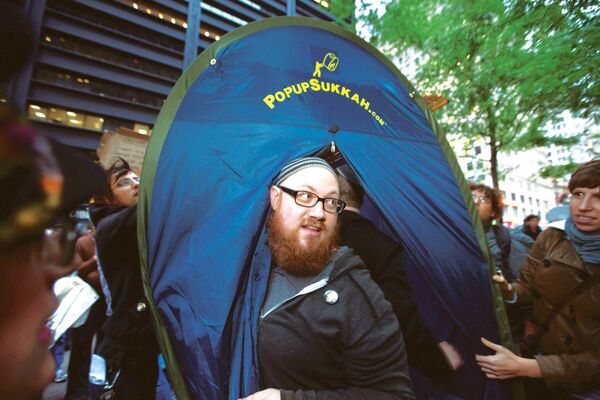
Dove Kent (former executive director, Jews for Racial and Economic Justice): We brought a large tent that a number of people could fit under for a Friday night service. Some cop came over and said, “You have to take that down.” We said, “No, it’s a sukkah, we can [legally] put this up.” So one of the other cops came over and said, “You can’t see three stars!”[32] I had just moved to New York, I had never lived in a place that had very many Jews. I was like, “The New York City police know halacha?” We took it down—but then we started conspiring with Dan to do a real Sukkot in Zuccotti Park.
Daniel Sieradski: Chabad gave me this pop-up sukkah. I showed up with it a few days later and put out a call for people to come protect it while we put it up, because we knew they weren’t letting structures go up in the park. So we get this big contingent of activists, press, and cops all at once. I start putting up the sukkah with Jewish anarchist squatters [who had been] sleeping in the park, and the cops are like, “What are you doing? You can’t put up a structure!” I’m like, “This is a Jewish ritual tabernacle for the holiday of Sukkot.” The cop got this look on his face, and said, “Okay, I’m not fucking with this,” and walked away. So we considered that our victory: The cops are afraid to touch this because of First Amendment issues, awesome.
The cops left and the press left, and it was just us in the sukkah. Night fell. It started raining [while] everybody was asleep on the pavement. In the middle of the night, I think it was [Occupy leader] Justin Wedes who stood up and said, “Mic check! If you are Jewish, or identify as a Jewish person, build yourself a sukkah!” And then everybody just built themselves structures in Zuccotti Park to sleep in. That was how the tent city started.
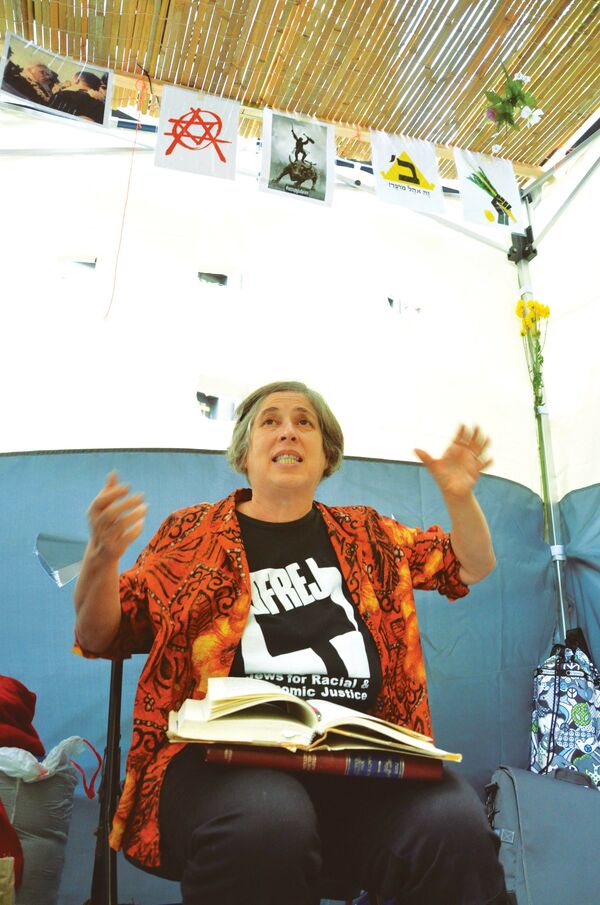
Dove Kent: After that, the occupation had tents, and people were able to sleep more comfortably. We would walk around and hear conversations happening between police and protesters saying, “It’s a sukkah! It’s a sukkah!”
Arthur Waskow: In Philadelphia, we built a sukkah right outside City Hall and talked about the real meaning of Sukkot.
Daniel Sieradski: I think it was the second night with the sukkah when [Mayor Michael] Bloomberg had issued an edict that the park had to be “cleaned.” They sent the cops at like four o’clock in the morning to clear us out. We moved the sukkah to the center of the park, and everybody formed concentric circles around it. I was inside the sukkah with my lulav[33]. The idea was that when the cops came, they would have to pull every circle away from around the sukkah and then have to pull me out of my sukkah davening. And that would be so destructive to Bloomberg; that would fucking ruin him. But thousands of people showed up and flooded the park that night, and it became unnecessary.
Audrey Sasson: I cried when I got out of the subway. It was 5:00 am, I got out of the subway, and I heard people. Nelini Stamp did a mic check that went six generations. I was like, this is what people power is. Literally, we will not be moved. The only way to move us is through a massacre.
“I start putting up the sukkah with Jewish anarchist squatters [who had been] sleeping in the park, and the cops are like, “What are you doing? You can’t put up a structure!” I’m like, “This is a Jewish ritual tabernacle for the holiday of Sukkot.” The cop got this look on his face, and said, “Okay, I’m not fucking with this,” and walked away.”
Daniel Sieradski: They couldn’t do shit and they called off the “cleaning.” The sukkah got destroyed by everybody pressing on it, because it was this shitty little pop-up sukkah with tent poles. The next day I took up a collection and bought a real sukkah, and it’s still the sukkah that I use every year.
Russ Agdern: Sukkos is a harvest holiday. It’s about impermanence and building a structure. It’s about welcoming guests. It’s about sharing your bounty with the community.
Getzel Davis: Literally, the Zohar says that if you don’t invite poor people into your sukkah then Abraham and Isaac and Jacob and all of their spirits are going to get up and leave.
Russ Agdern: You don’t have to try hard or make any of this shit up. It’s already there.
Unraveling and Aftermath
Audrey Sasson: After that is when the police repression got real bad. So much happened in that time around people’s understanding of policing, like the importance of the fight against stop-and-frisk.
Juan Carlos Ruiz: I remember the city doing this crazy maneuver of telling the homeless, “Oh, go with the occupiers, they’ll feed you.” All of a sudden, we had large groups of people that were very much marginalized and suffering from that marginalization. We had homeless people, a lot of people with mental illnesses, and we began dealing with that, asking ourselves, “How do we as a movement care for these people?”
Shellyne Rodriguez: I started to see shit happening at Occupy that I didn’t know how to solve, that I continue to not know how to solve. Mentally ill, unhoused people flooded the park because there was free food and community. But that meant people unequipped to deal with people in crisis were having confrontations with mentally ill people.
Liza Behrendt: I remember feeling very disturbed by the dynamics between unhoused people living in Zuccotti Park and voluntary occupiers, people who were choosing to be there. I would hear people in the General Assembly complain about the presence of unhoused people in the park, and complain about the presence of drugs, claiming that people were there to mooch and weren’t truly committed to the cause. Really gross things to be saying about a supposedly anti-capitalist movement that’s trying to build a little utopian society. There were times when the park was actually segregated, with one end of the park seen as the place where unhoused people were congregating, and the other end—where the General Assembly happened—where the younger, whiter, richer activists would be.
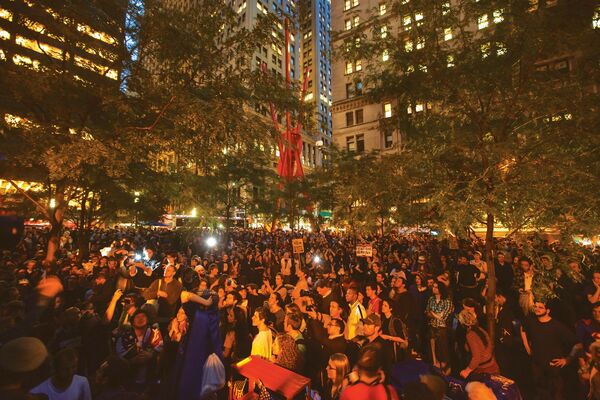
Audrey Sasson: Once, during a Spokes Council[34] meeting, they called the fucking cops on one of the homeless folks who were holding the space. They decided not to press charges, but they kicked him out of the space. All this is happening on one side of the room. On the other side of the room, white men are taking up the majority of the space talking. It was like, “What the fuck is happening? This cannot be what we’re trying to build.”
Liza Behrendt: I remember feeling really upset about this and not having a good sense of how to tackle it. I was not yet at the place of understanding that, actually, it’s the unhoused people who should be at the center of this movement. The question shouldn’t just be, “How do we all work together?” It should be, “How does a movement against capitalist greed actually center and uplift people who are occupying this space because they literally have nowhere else to go?”
Daniel Sieradski: [With Occupy Judaism,] I was trying to create a space where anti-Zionists and progressive Zionists could cohabitate to fight for common values. It was like the precursor to IfNotNow in that regard. As long as the question was the growth of CEO pay and banks getting bailed out, liberal Jews were supportive. But when Occupy started trying to be an intersectional movement, everybody started getting really, “Oh wait a minute, now. I don’t agree with that.”
Getzel Davis: I was really excited about Occupy when it seemed like its focus was on a domestic agenda. When it started to talk about international politics, it felt like it was falling out of alignment with me. The way that Occupy got involved in Israel/Palestine created a fissure. It became a more complicated place for me, and for a lot of people who were more attached to the Jewish establishment but squarely shared the [movement’s other] values. I came less and less often.
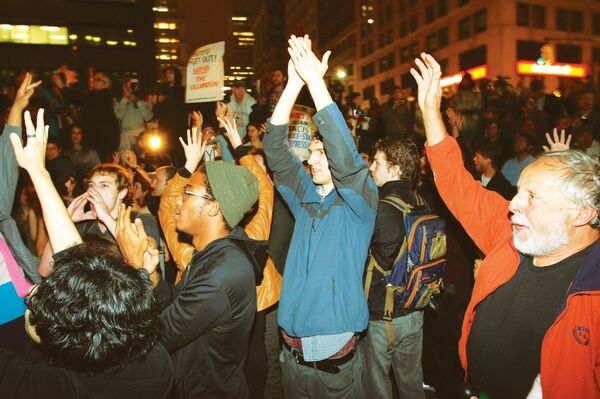
Daniel Sieradski: When the General Assembly endorsed Occupy AIPAC[35] I had intended to be there for that conversation. They knew I was going to raise issues, so they did an end run around me and brought it to the GA when I wasn’t there so that I couldn’t protest. Another time, I complained about tweets from the Occupy Twitter account about the Gaza flotilla[36]—I expressed my frustrations to a friend who ran the account about how I had just put all this energy into getting the “Occupy is antisemitic” story put to rest only to be sandbagged by this, and he took the tweets down. Now, I feel like an asshole. Now I understand how issues intersect, but I was resistant to that thinking before. I just didn’t know what the fuck I was doing yet. And I think it had grave consequences. Occupy Judaism just died after that.
Amin Husain: [The approach to] Palestine makes clear that Occupy was never an anti-imperial movement. It’s not unique to Occupy. It’s a problem we face in the United States. We think that if we just fix things here, everything will be okay. And that just doesn’t make any sense. Capital is global, so why wouldn’t our struggles be?
Daniel Sieradski: The Zionists couldn’t let go of the idea that Occupy had no business talking about Israel. So they left. We lost a ton of energy and it kind of dissipated after that.
Audrey Sasson: By the time we got evicted[37], we were mired in internal dynamics that were really hard. Because of course we’re still living in a racist, patriarchal, horrible society. And so all that shit started coming into the space.
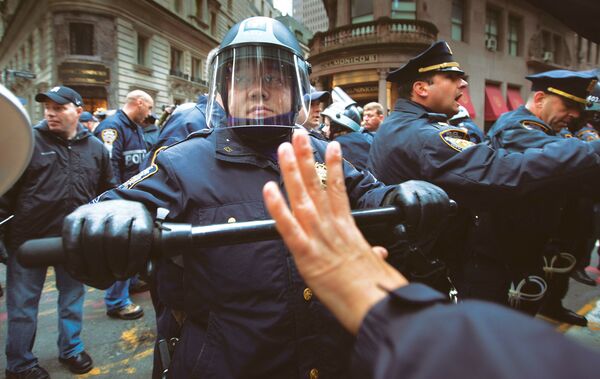
Shellyne Rodriguez: You got fuckboys, you got people with differing politics who were dogmatic, you got egos and characters and narcissists and sociopaths. It’s always the bag. And the minute it happens, it’s already over. NGOs are already plotting. They’re already writing a grant.
Audrey Sasson: After the eviction, there was no touchstone. I can’t believe I’m saying this, but it almost felt at the time like the equivalent of the destruction of the Temple. But it was a blessing in disguise. I took a kind of diasporist position on it, because actually we couldn’t be connected to a single space, especially when the space was starting to manifest really troubling dynamics, which were at risk of becoming entrenched. We had to go into the world and do the work.
Carolyn Klaasen: I remember for the first year after Zuccotti Park was no more, it felt like the energy that had been there was rerouted to all these different movements and places. People were fired up about organizing. Occupy was a common reference point and an easy way of bonding with people. I rode that energy for a long time.
Max Berger: I remember, [after Occupy ended,] people would ask me, “Was Occupy a failure?” And I was like, “I think it will be judged on what we do in the next ten years.” I think that’s still basically right. It was very immature, it was very naive, it was very formless. But it had all the energy that our generation would put into a lot of other things.
“You got fuckboys, you got people with differing politics who were dogmatic, you got egos and characters and narcissists and sociopaths. It’s always the bag. And the minute it happens, it’s already over. NGOs are already plotting. They’re already writing a grant.”
Amin Husain: I remember having a conversation with Frances Fox Piven[38], who told me movements take about ten years to mature in their analysis, and here we are.
Yotam Marom: We started IfNotNow in the summer of 2014. The war on Gaza[39] had just started, and a few of us were like, “Jews have to do something.” Those were people I either met at Occupy, or who became strong partners [for me] because of Occupy.
Carinne Luck: I do think there were people who were leaders at Occupy who were also Jewish and had never really expressed that Jewishness before. I feel like the Jews on the left got a little more Jewish after Occupy Judaism.
Tamara Shapiro: There were three of us who were Jewish who created training programs after being deeply involved in Occupy. [Yotam] looked at Occupy and was like, “One reason this fell apart is because we didn’t have strong groups. We need to create a training program to build stronger organizing.” So he started the Wildfire Project[40]. [Max Berger] was like, “One reason this didn’t work is because we didn’t have good boundaries for understanding what is in the movement and what’s outside the movement.” Because anyone could claim Occupy, and that meant that some people were claiming it who had really different values than other people. So he helped start a program called Momentum[41]. And then a few [of us] who had been deeply involved in Occupy Sandy[42] were like, “Actually, we did a lot right. We need to create trainings so people understand how to use these kinds of structures we’re doing naturally.” So that became Movement Netlab[43]. Then in 2014, when the Gaza War was happening, the three of us came back together with other people to support the start of IfNotNow, and all of our lessons were part of that.
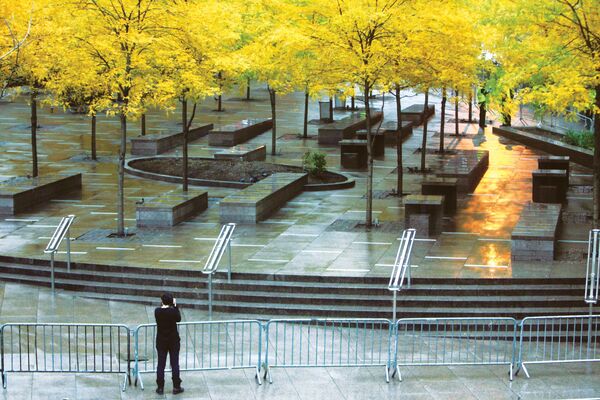
Karen Isaacs (co-founder, All That’s Left Anti-Occupation Collective): The thing All That’s Left[44] took from Occupy was that we didn’t want to be an entity at all, we just wanted to be a hashtag. Leftists tend to get very ideologically specific and only want to work with people who see things the same way, but Occupy didn’t do that. We wanted to follow that example. We said that there was one sentence that united this collective, and anyone who identified with that sentence could be part of our organizing; as long as a bunch of people wanted to do a thing, we’d do that thing.
Getzel Davis: The Jewish community discovered that it can use holidays as opportunities for action. Maybe that could have happened without Occupy, but that was the first place I ever saw it. Two years ago there was a fast day, and we were out protesting ICE. And that felt normal, to have 30 or 40 rabbis in Boston giving sermons and speeches and blowing shofars.
Dove Kent: JFREJ was on the ropes and in a tough place financially; many people thought it wouldn’t survive. But folks who were looking to build a new kind of Jewish institution—with wildly different politics and ways of working from what they’d experienced in most other institutions—brought that energy to JFREJ, as did the people who wanted to see JFREJ effect material change through existing institutions. I think that because there was room at Occupy for both, those different parts of the ecosystem also met in a reinvigorated JFREJ membership.
Amin Husain: [Occupy gave us] a mode of outreach where you didn’t have to put up a flyer and a Facebook page and an Instagram post. You just had to show up, and like-minded people would show up. It was a site both of desire and of the enactment of that desire. It didn’t separate direct action from organizing, or a library from teaching, or childcare from whatever. That’s not to romanticize it or be nostalgic about it.
Shellyne Rodriguez: Despite all of the race and class bullshit that Occupy is charged with, I am not one of those people that bashes Occupy. To me, it did what it needed to do. It did what it could do at that moment. Occupy couldn’t have been better than it was because it didn’t have a framework. Like, with the concept of the 99% versus the 1%, we can split hairs about how accurate that is, but it provided an image. The direct action training and the concept of holding space, of going and filling public squares with your body, setting up shop—all of those concepts came from Occupy. It needed to be a mess to give birth to all of the things it gave birth to.
“Occupy changed what was possible, it changed what people are able to imagine. That’s what you need. Otherwise you’re fucking stuck. So we got a little unstuck, and we have to be grateful for that. ”
Amin Husain: We often tell people that Occupy centered class and fucked everything else. But after the 2014 Gaza War and the Black Lives Matter eruption in Ferguson, people that were in my affinity group at Occupy found me and said, “I now understand white supremacy.” When it was time for Black Lives Matter to erupt, the infrastructure was lent, and the bodies were lent, and the knowledges were lent, and the direct action philosophy was applied.
Carolyn Klaasen: This last presidential election campaign, I found myself thinking about Occupy a lot. My dad was a Republican until Trump, and a lot of the ways that Bernie Sanders and Elizabeth Warren talked about wealth were resonating with him. I felt like we were seeing this big political conversation that had taken hold of the public imagination at Occupy actually have an impact on policy, and on how people run for political office. It feels like one of the big events that energized a generation, and it brought me personally to a different level of political thinking and dreaming.
Liza Behrendt: I think it did not advance class analysis too far on the Jewish left. It’s so rare that I’m in a Jewish space where working-class Jews are even acknowledged, let alone uplifted and affirmed, or in leadership. I feel like we have a long way to go in terms of talking about class in Jewish spaces. The 99%-versus-1% model makes it easy for people who have class privilege and comfort to pass the buck and say, “We’re not the problem.” Sure, in one sense we’re not, it’s the 1% that has the political power. But we still have a disproportionate responsibility to redistribute wealth and resources.
Audrey Sasson: We on the left are very good at critique. We just love it, you know. So we miss the point half the time because we’re spending so much time being smart. Stop being so fucking smart. Like, this didn’t exist, this container wasn’t here. Trust me, because for 15 years, I organized in the fucking desert.
So many things came together in that moment. You can’t create that shit. When it comes, you seize it, you try to amplify it as much as possible. That was the gift of Occupy. It changed what was possible, it changed what people are able to imagine. That’s what you need. Otherwise you’re fucking stuck. So we got a little unstuck, and we have to be grateful for that.
Occupy unfolded shortly after the Arab Spring—a series of anti-government uprisings concentrated in Libya, Egypt, Yemen, Syria, and Bahrain—and anti-austerity protests in Greece.
An anarchist anthropologist and activist who was a major Occupy leader, as well as the author of Debt: The First 5000 Years and Bullshit Jobs. He died in September 2020.
On September 24th, 2011, a police officer pepper sprayed four women during an Occupy march near Union Square; the incident was captured on photo and video and widely circulated.
At Occupy, General Assemblies—which were composed of anyone who showed up at meetings and wished to participate—functioned as the primary decision-making bodies. The GAs were guided by a philosophy of direct democracy and governed according to participant consensus.
At General Assembly meetings, participants communicated in part by means of hand signals. For instance, both hands raised with fingers wiggling (“up twinkles”) signaled agreement to a proposal, while arms held up and crossed (“hard block”) signaled firm opposition.
An amplification technique (also called “the human microphone”) in which someone speaks in short phrases, which are repeated by people who can hear them, sometimes in successive waves of repetition. The people’s mic was popular at Occupy because of New York regulations restricting the use of megaphones.
On September 21st, 2011, Troy Davis—a Black man convicted of the 1989 murder of a police officer—was executed in Georgia, after years of stays and appeals, including intervention by the US Supreme Court. Many people who maintained Davis’s innocence protested the execution.
A debate emerged over whether the Occupy movement should put forward a list of specific demands. Some participants maintained that the lack of demands was a strength; others objected that it made the movement seem too nebulous or unserious.
A milieu of independent, egalitarian Jewish prayer groups, unaffiliated with particular synagogues or denominations, that emerged among Jews in their 20s and 30s in cities across the US in the early 2000s.
A traditional Jewish stew, often served on Shabbat.
A New York City–based folk singer.
Jewish hymns.
A program of Birthright Israel, a nonprofit organization founded in 1999 that sponsors free trips to Israel for young American Jews. Birthright NEXT, which ran from 2008 until 2015, hosted events intended to help Jews who went on Birthright trips maintain a connection to Israel.
Steven L. Pease, author of The Golden Age of Jewish Achievement.
On October 1st, 2011, a large group of Occupy participants marched onto the Brooklyn Bridge, where more than 700 people were arrested. Many protesters accused police of trapping them there.
For example, in a January 2012 article in the right-wing Jewish magazine Commentary, Jonathan Neumann wrote, “The tone [of Occupy], very early on, was set in part by signs and messages that were overtly anti-Semitic.”
Jewish religious law.
A 13th-century text (literally “Book of Education”) that provides commentary on each of the 613 mitzvot, or Jewish religious commandments.
A Jewish investor, hedge fund manager, and philanthropist who helped found Birthright Israel.
Jewish prayer books used on Rosh Hashanah and Yom Kippur.
The main seminary for rabbis in the Conservative movement.
An evening Jewish prayer service.
A High Holy Days prayer book published in 2011. According to the Rabbinical Assembly, the machzor “seeks to embrace the diverse backgrounds and expectations in each of our communities and open doors for every congregant.” It includes English translations and transliterations of Hebrew text.
White robes worn by Jews on specific religious occasions (including Yom Kippur) and for burial.
A quorum of ten Jewish adults (or traditionally, adult Jewish men) required to perform certain religious rituals.
Jewish holidays.
Observant of Jewish religious law; often used to describe Orthodox Jews.
Animal sacrifices made at the ancient Temples in Jerusalem.
The prayer that closes each of the three daily Jewish services.
The traditional Haftarah reading on Yom Kippur comes from the Book of Isaiah, in which the speaker decries self-serving, individualistic ritual fast days, and calls for a fast day instead oriented toward ending social oppression: “Is such the fast I desire, / A day for men to starve their bodies? / Is it bowing the head like a bulrush / And lying in sackcloth and ashes? . . . No, this is the fast I desire: / To unlock the fetters of wickedness, / And untie the cords of the yoke / To let the oppressed go free; / To break off every yoke” (Isaiah 58:5–6, Jewish Publication Society Tanakh).
A form of social movement organization based in non-hierarchical decision-making and direct democracy. Derived from the Spanish term “horizontalidad,” the concept was popularized on the left during the 2001 rebellion in Argentina.
According to Jewish lore, a temporary structure built for the holiday of Sukkot must have a roof sparse enough for three stars to be visible in order to count as a sukkah.
A ritual object used on Sukkot, made from myrtle, palm, and willow leaves.
The governing body of Occupy Wall Street, consisting of individual representatives of various working groups who rotated each meeting, which began operating in November 2011. Unlike the General Assembly, the Spokes Council met indoors and used microphones.
An initiative by CodePink and Jewish Voice for Peace to disrupt an upcoming American Israel Public Affairs Committee (AIPAC) conference using Occupy tactics.
On November 4th, 2011, two ships commissioned by activist groups attempted to circumvent Israel’s blockade of the Gaza Strip to deliver medicine. Members of the Israeli military boarded the ships and prevented their arrival. The Occupy account sent a tweet expressing solidarity with the flotilla effort, then deleted the tweet an hour later.
On November 15th, 2011, around 1:00 am, New York Police Department officers raided Zuccotti Park, ordering Occupy Wall Street protesters to leave, removing tents, and arresting resisters. The eviction marked the official end of the Occupy Wall Street encampment in New York City.
Professor of political science and sociology at the City University of New York.
In July 2014, Israel invaded Gaza in response to rocket fire from Hamas in an offensive known as “Operation Protective Edge.” The United Nations estimates that across 50 days of conflict, 2,205 Palestinians and 71 Israelis were killed.
A nonprofit that helps grassroots groups strengthen their internal dynamics and organizing culture.
A training institute that supports the creation of social movements, based on an organizing strategy in which an initial team develops founding principles that can be adopted by self-organized movement members. Sunrise Movement, Cosecha, Dream Defenders, and IfNotNow are all part of the Momentum network.
A relief effort to coordinate resources for victims of Hurricane Sandy in 2012, created by Occupy Wall Street veterans.
An organization that supports social movements in developing decentralized, self-organized structures.
An Israel-based collective that organizes against the occupation of Palestine.
